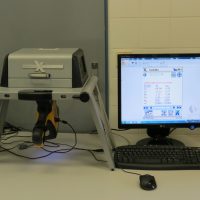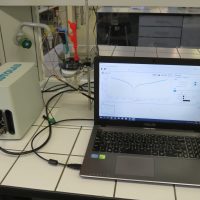Analytical explorations
The outputs from the analyses are summarized results of internal projects and requirements of external contracting entities. The laboratory of the Methodological centre for conservation offers conducting of stratigraphic survey of coats and plasters by optical microscopy, preparation of metallographic mounts and analysis of the element composition of metal objects by a portable X-ray fluorescence spectrometer.
Optical microscopy
Digital microscope Keyence VHX-700F
The technological laboratory is equipped with digital microscope Keyence VHX-700F to carry out microscopical survey of collection items. This microscope has a Z-axis motorized stage and offers digital record and a detailed capturing of reliefs, ornamentations, or material structure with a big depth of field. It can also create a 3D model of the surface. Another advantage of the microscope is the external work with it without clamping it to the stand. This is suitable when exploring big objects.
Optical microscope Olympus BX60
The workplace is equipped with microscope Olympus BX60 to observe flat samples, stratigraphic and metallographic mounts. The microscope works with magnification of 50–1000 x. Apart from normal illumination, also polarized light or UV-light can be used. It is also possible to prepare mounts of samples by casting into resin, by grinding and polishing in the laboratory.
XRF spectrometer Innov-X Delta
The Methodological centre for conservation is equipped with portable X-ray fluorescence spectrometer Innov-X Delta. The X-ray fluorescence analysis is based on the detection of the secondary X-ray radiation. This radiation is emitted from a sample after interaction with the primary X-ray radiation emitted from the X-ray tube of the device. The spectral lines of the secondary radiation are characteristic for the given elements through which they are directly qualitatively set. The signal intensity corresponds with the content of the element in the sample. Analyses of element composition particularly of metal and ceramic objects, metal coats and the like can be carried out by this device. Thanks to small dimensions, a simple construction and operation it is possible to carry out in situ analyses, for example during archaeological explorations.
Potentiostat Metrohm Autolab PGSTAT 204
This device enables to study corrosion products on metal objects (particularly copper, silver, and lead). It is possible to set and carry out their treatment by means of electrolytic reduction. The device can be also used for study of metal and alloy corrosion in the selected corrosion environment.








